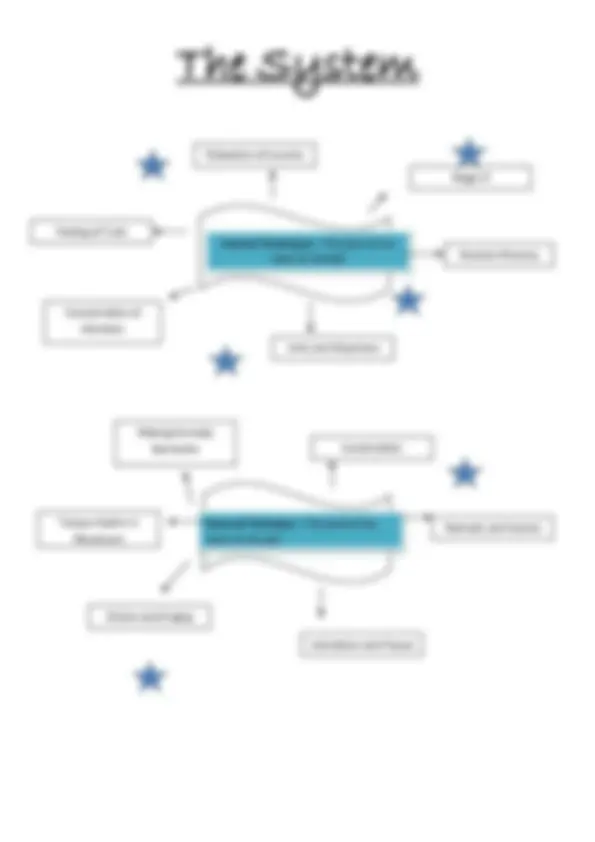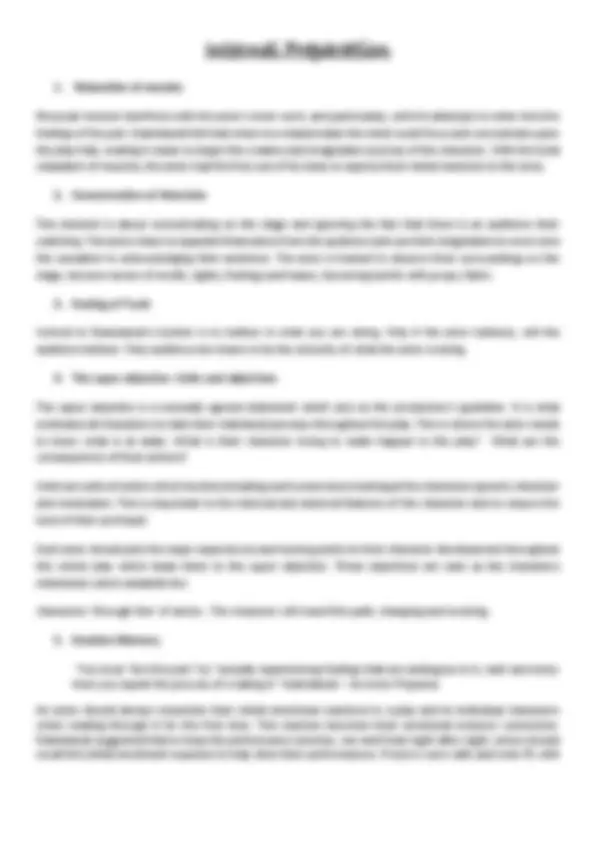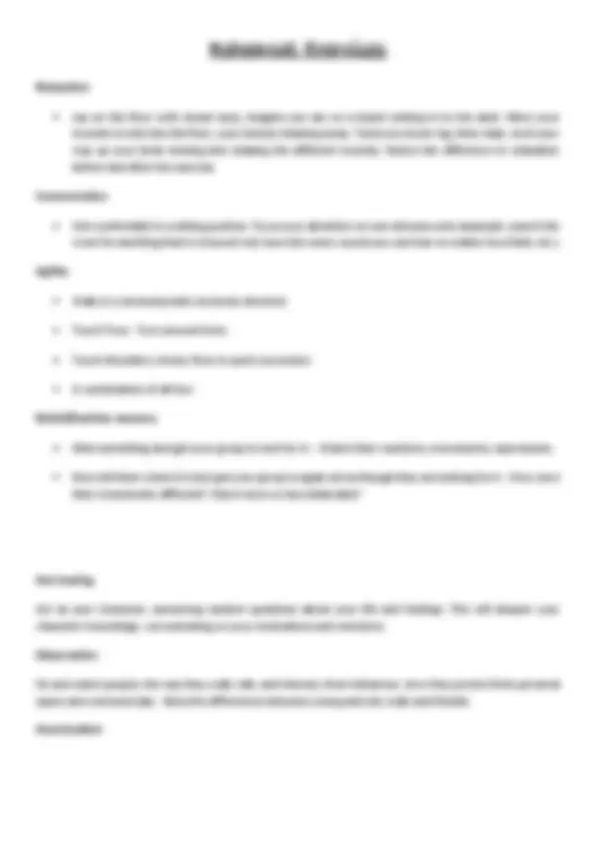







Study with the several resources on Docsity

Earn points by helping other students or get them with a premium plan


Prepare for your exams
Study with the several resources on Docsity

Earn points to download
Earn points by helping other students or get them with a premium plan
Community
Ask the community for help and clear up your study doubts
Discover the best universities in your country according to Docsity users
Free resources
Download our free guides on studying techniques, anxiety management strategies, and thesis advice from Docsity tutors
An overview of Stanislavski's acting method, also known as the Stanislavski System. The method, which focuses on helping actors create 'truthful' performances, includes both internal and external techniques for analyzing and portraying characters. Actors are encouraged to relax, feel truth, and develop their physicality, as well as to analyze the given circumstances and use their imagination to embody their characters.
What you will learn
Typology: Study notes
1 / 9

This page cannot be seen from the preview
Don't miss anything!






Stanislavski the Theatre Practitioner A Theatre Practitioner is someone who creates theatrical performance and/or writes theatrical ideas and teachings. Russian born, Constantan Stanislavski was a theatre practitioner who also acted and directed throughout his career. He formed the Moscow Art Theatre and is most commonly known for his system. The ‘System’ was Stanislavski’s acting method, born out of a quest for realism in acting. A set of rules and exercises created a foundation for actors to work from. Stanislavski inspired and his system came before any major acting techniques developed in America. Stanislavski’s primary concern was with the actor and in particular the methods by which the actor could attain a ‘truthful’ performance. The principle objective of his system was to aid the actor in creating an illusion of actuality on stage and in convincing the audience that he (the actor) was portraying a real person, convincing his audience that his feelings and thoughts were exactly those of the character he embodied. The ‘actor as character’ is however an aspect of the system which is often misunderstood. Stanislavski did not want the actor to lose himself in the role and constantly live as the character even in his own life, but be able to separate themselves when not in performance and rehearsal. Stanislavski was fond of quoting Tomaso Salvini on this theme: ‘An actor lives, weeps and laughs on the stage, and all the while he is watching his own tears and smiles. It is this double function, this balance between life and acting that makes his art.’ (Meyer- Dinkgrafe, 2001, pg. 42) He taught that an actor must prepare his role in great detail, with a large amount of attention to the psychology, the motivation and the lifestyle of the character. It is important to be clear, Stanislavski does not teach you how to act, he teaches you how to work with yourself, how to organise your own creativeness and use your inner body to create the external show, it gives him a purpose. The Stanislavski system uses Internal and external techniques to gain a full analysis of the character and how they should be portrayed. Knowing the physiology of a character, their thoughts and desires and what motivates them is vital in the portrayal of a character successfully. The preparatory work on a role can be divided into three areas. Textual analysis, establishing life (internal) and transferring it to physical form (external). When studying a role, you are first greeted with a first impression. This first impression is significant to the creativeness of the role. Impressions are unexpected but direct, leaving you with a permanent mark. First impressions can be likened to seeds. The seed of imagination is planted and the next work you do, gives your seed growth and life; the next work you do on your character determines the growth and development. You have to be careful not to have pre-determined prejudices because this will ruin your characters beginning. After reading the play, an actor will study and analysis every element of the script looking and deciphering clues as to how their character should be portrayed.
Internal Techniques – The work of the actor on himself External Technique – The work of the actor on his part Relaxation of muscles Feeling of Truth Units and Objectives Emotion Memory Concentration of Attention ‘Magic If’ Making the body Expressive Accentuation Tempo-rhythm in Restraint and Control Movement Diction and Singing Intonations and Pauses
1. Relaxation of muscles Muscular tension interferes with the actor’s inner work, and particularly, with his attempts to enter into the feelings of his part. Stanislavski felt that when in a relaxed state the mind could focus and concentrate upon the play fully, making it easier to begin the creative and imaginative journey of the character. With the total relaxation of muscles, the actor had the free use of his body to express their initial reactions to the story. 2. Concentration of Attention This element is about concentrating on the stage and ignoring the fact that there is an audience their watching. The actors have to separate themselves from the audience and use their imagination to overcome the sensation to acknowledging their existence. The actor is trained to observe their surroundings on the stage, become aware of smells, sights, feelings and tastes, becoming tactile with props, fabric. 3. Feeling of Truth Central to Stanislavski's System is to believe in what you are doing. Only if the actor believes, will the audience believe. They audience are drawn in by the sincerity of what the actor is doing. 4. The super objective- Units and objectives The super objective is a mutually agreed statement which acts as the production’s guideline. It is what motivates all characters to take their individual journeys throughout the play. This is where the actor needs to know what is at stake. What is their character trying to make happen in the play? What are the consequences of their actions? Units are units of action which involves breaking each scene down looking at the characters speech, intention and motivation. This is important to the internal and external features of the character and to ensure the tone of their portrayal. Each actor should plot the major experiences and turning points in their character development throughout the whole play which leads them to the super objective. These objectives are seen as the characters milestones which establish the characters ‘through-line’ of action. The character will travel this path, changing and evolving. 5. Emotion Memory ‘You must “live the part” by “actually experiencing feelings that are analogous to it, each and every time you repeat the process of creating it.’ Stanislavski – An Actor Prepares. An actor should always remember their initial emotional reactions to a play and its individual characters when reading through it for the first time. This reaction becomes their emotional memory connection. Stanislavski suggested that to keep the performance emotive, raw and fresh night after night, actors should recall this initial emotional response to help drive their performances. If actors were safe (and only IF) with
1. Making the body expressive Stanislavski thought that an actor’s body should be physically prepared, he felt the body should be toned and agile, with stamina and flexibility. Only then can an actor fully challenge himself to embrace any character. He felt that without this an actor’s own body would distract from the full portrayal. Stanislavski felt that with physical fitness came confidence and also allowed for an actor to instantly interpret a character’s stance and portray emotions and mannerisms. Stanislavski often challenged the actor’s physicality and body awareness, linking jumping in training to jumping internally at the sound of their cue line, making it become second nature. 2. Restraint and Control An actor must rid himself of all superfluous gestures. A performance which is cluttered with unnecessary gestures is like a piece of paper covered with marks. The paper must be clear before someone can create an intimate sketch. The actor is told to resist and control their own self urges of reaction when it is not in their characters interest to do so. This comes by understanding fully your characters units and objectives. 3. Diction and singing Stanislavski believed that every actor must be in possession of excellent diction and pronunciation. He compares an audience listening to an actor with poor speech to trying to read bad handwriting. The study and practice of words as the character is vital to performance. Singing is used to find the full range of an individual’s voice. 4. Intonations and Pauses Stanislavski warns against monotone speech, unless it in the characters portrayal. Parrot-like delivery of lines learned by heart without use or recognition of inner emotion is not deemed acceptable. How we say something, the pitch, the rise and fall, the pauses which create the tension can be identified through the meaning behind what is said. 5. Accentuation The accent in a sentence is the expressive word, the pointing finger. It singles out the key word in a phrase; this word is the soul, the inner essence, and emphasis the characters motivation. Emphasising the incorrect word in a sentence can change the context and meaning of the whole story. Being clear of what is to be accentuated is vital. 6. Tempo-Rhythm and movement Tempo is how fast or slow something is said. The varying speeds and timings of the actions and speech on stage coincide to produce a rhythm. How we say something emphasises our feeling, emotions and motivations. Understanding the sub-text will ensure you portray the right messages. How many different ways can u say, I love you? What do they mean?
Relaxation